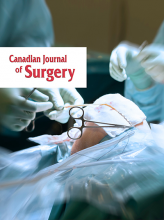Health Canada’s “Clinical practice guidelines for the care and treatment of breast cancer”1 states that levels I and II axillary lymphadenectomy should be considered as part of the standard care for patients having early breast cancer. Axillary dissection provides important staging information that can be used to estimate prognosis and subsequently to plan further systemic and radiation treatment. Axillary lymphadenectomy provides excellent long-term regional control from nodal metastases and may well have an impact on survival.2 However, these benefits come with a price: the procedure is associated with postoperative pain, a possible reduction in the range of shoulder movement, some cutaneous numbness and dysesthesia, physiologic distress and, in some, significant lymphedema.1
The quest for an accurate staging procedure with a reduced complication rate has led to the acceptance by some of the sentinel lymph-node (SLN) biopsy. Certainly, lymphatic mapping and SLN biopsy as pioneered by Krag and associates,3 Giuliano and associates,4 Borgstein and associates5 and others6 have clearly changed our understanding of the biology of regional breast cancer metastases. Many techniques have been used and their use has been reviewed.7 Essentially, the SLN is the primary node that receives lymphatic drainage from a tumour, and its pathologic status appears to reflect the status of the nodal basin. Subsequent studies illustrated 2 important facts: first, precise identification and histologic assessment of the SLN can be accomplished in most breast cancer patients who undergo primary surgery and can provide accurate staging information; second, success and accuracy are associated with a significant learning phase and are only achieved after considerable experience with the technical aspects of lymphatic mapping, surgical biopsy and pathologic interpretation of the SLN. Krag and colleagues8 found that the ability to successfully find an SLN, as defined by the identification of a “hot spot” after technetium sulfur colloid injection, was surgeon-dependent. The false-negative rate also varied considerably (from 0% to 28.6%) among surgeons.
Currently, there is tremendous interest in SLN bipsy from both surgical and patient communities. Many surgeons are keen to learn the technique and incorporate the procedure into their practice. Yet, given the staging accuracy (95% to 97%) of the currently recommended levels I and II axillary node dissection, and the regional control and possible survival benefits, we believe that surgeons must be able to achieve, document and maintain at least a 90% rate of successfully finding a sentinel node and a false-negative rate of less than 5% before they discontinue the accompanying axillary lymphadenectomy. It should also be noted that within the population of patients with nodal metastases, only a small percentage of the axillary nodes are positive (e.g., 1 to 3 nodes positive out of 10 to 15 nodes = 7% to 30% positive). Therefore, a poorly performed SLN biopsy (a random node biopsy is the extreme) will more than likely give a false-negative result, and the ramifications regarding prognosis and selection of adjuvant chemotherapy and radiotherapy are significant. If an SLN cannot be successfully identified, then the standard levels I and II axillary node dissection should be done.
Sentinel lymph-node biopsy has now reached the point at which it should be compared to a conventional levels I and II axillary dissection in randomized clinical trials of clinically node-negative breast cancer patients. Both the National Surgical Adjuvant Breast Project and the American College of Surgeons have initiated studies that will determine whether sentinel-node resection can provide equivalent or better regional control, disease-free survival and overall survival, and if these results can be achieved with less morbidity. All centres are encouraged to participate in these trials. However, until these studies have been completed and the use of SLN biopsy is validated, the Canadian Society of Surgical Oncology stands by the current practice guidelines that incorporate levels I and II axillary dissection as part of standard breast cancer treatment. Our recommendation is that Canadian general surgeons plan to acquire the necessary equipment, collaborate with their nuclear medicine and pathology colleagues to build an expert team, complete a recognized training program designed to teach the technique and perform a minimum of 30 SLN biopsies with concurrent levels I and II axillary lymph-node dissections in order to document proficiency and accuracy. Thirty SLN biopsies and axillary dissections should provide about 10 positive axillary node biopsies and thus provide some basis for calculating an individual surgeon’s false-negative rate. If the standard axillary dissection is not part of the treatment plan, the patient should be fully informed, not only of the possible benefits of reduced axillary morbidity but also the current state of knowledge, the individual surgeon’s false-negative rate and possible consequences of a false-negative result. The sentinel-node biopsy has the potential to reduce morbidity from breast cancer surgery, but it must be incorporated into practice with due diligence.
Footnotes
↵* Endorsed by the Executive of the Canadian Society of Surgical Oncology.









